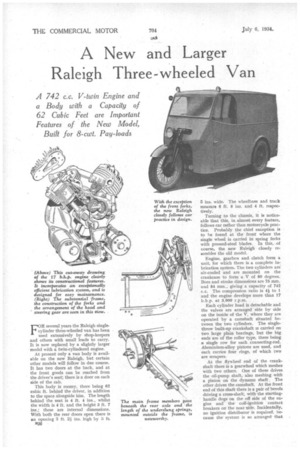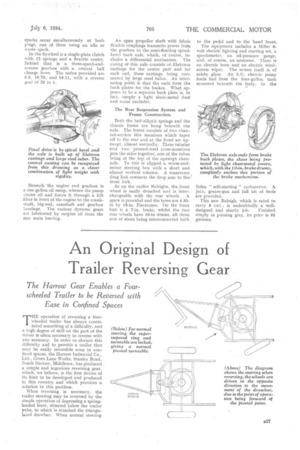A New and Larger Raleigh Three-wheeled Van
Page 44

Page 45

If you've noticed an error in this article please click here to report it so we can fix it.
A 742 c.c. V-twin Engine and a Body with a Capacity of 62 Cubic Feet are Important Features of the New Model, Built for 8-cwt. Pay-loads
FOR several years the Raleigh singlecylinder three-wheeled van has been used extensively by shop-keepers and others with small loads to carry. It is now replaced by a slightly larger model with a twin-cylindered engine.
At present only a van body is available on the new Raleigh, but certain other models will follow in due course. It has two doors at the back, and at the front goods can be reached from the driver's seat: there is a door on each side of the cab.
This body is roomy, there being 62 cubic ft. behind the driver, in addition to the space alongside him. The length behind the seat is 4 ft. 4 ins., whilst the width is 4 ft. and the height 3 ft. 7 ins.; these are internal dimensions. With both the rear doors open there is an opening 3 ft. 21 ins, high by 3 ft.
826
5 ins. wide. The wheelbase and track measure 6 ft. 8 ins. and 4 ft. respectively.
Turning to the chassis, it is noticeable that this, in almost every feature, follows car rather than motorcycle practice. Probably the chief exception is to he found at the front where the single wheel is carried in spring forks with pressed-steel blades. In this, of course, the new Raleigh closely resembles the old model.
Engine, gearbox and clutch form a unit, for which there is a complete lubrication system. The two cylinders are' air-cooled and are mounted on the crankcase to form a V of 80 degrees. Bore and stroke dimensions are 75 mm. and 84 mm., giving a capacity of 742 c.c. The compression ratio is 44 to 1 and the engine develops more than 17 b.h.p. at 3,000 r.p.m.
Each cylinder head is detachable and the valves are arranged side by side on the inside of the V. where they are operated by a camshaft situated between the two cylinders. The singlethrow built-up crankshaft is carried on two large plain bearings, but the big ends are of the roller type, there being a single row for each connecting-rod. Aluminium-alloy pistons are used, and each carries four rings, of which two are scrapers.
At the flywheel end of the crankshaft there is a gearwheel which meshes with two others. One of these drives the oil-pump shaft, also meshing with a pinion on the dynamo shaft The other drives the camshaft. At the front end of this shaft there is a pair of bevels driving a cross-shaft, with the startinghandle dogs on the off side of the engine and the coil-ignition contact breakers on the near side. Incidentally, no ignition distributor is required, because the systemis so arranged that sparks occur simultaneously at both pings, one of them being an idle or waste spark.
In the flywheel is a single-plate clutch with 12 springs and a flexible centre. Behind that is a three-speed-andreverse gearbox with a central ball change lever. The ratios provided are 6.5, 10.73, and 19.11, with a reverse gear of 25 to 1.
Beneath 'the engine and gearbox is a one-gallon oil sump, whence the pump draws oil and forces it through a felt filter in front of the engine to the crankshaft, big-end, camshaft and gearbox bearings. The various dynamo gears are lubricated by surplus oil from the rear main bearing. An open propeller shaft with fabric flexible couplings transmits power frail the gearbox to the semi-floating spiralbevel hack axle, which, of course, ineludes a differential mechanism. The casing of this axle consists of-Elektron castings for the centre part and for each end, these castings being connected by large steel tubes. An interesting point is that the ends form the back plates for the brakes. What appears to be a separate back plate is, in fact, simply a light sheet-metal dust and water excluder.
The Rear Suspension System and Frame Construction.
Both the half-elliptic springs and the chassis frame are hung beneath the axle. The frame consists of two channel-section side members which taper oil to the rear and at the front are upswept, almost vertically. Three tubular and two pressed-steel cross-members join the sides together, one of the tubes being at the top of the upswept channels. To this is clipped a worm-andsector steering box with a short and almost vertical column. A transverse drag link connects the drop arm to the front fork.
As on the earlier Raleigbs, the front wheel is easily detached and is interchangeable with the rear wheels. A spare is provided and the tyres are 4.50in by 18-in. Firestorms. On the front hub is a 7-in, brake, whilst the two rear wheels have 10-in drums, all three sets of shoes being interconnected both to the pedal and to the hand lever.
The equipment includes a Miller 6volt electric lighting and starting set, a speedometer, an oil-pressure gauge, and, of course, an ammeter. There is an electric horn and an electric windscreen wiper. The screen itself is of safety glass. An S.U. electric pump feeds fuel from the four-gallon tank mounted beneath the body, to the Solex " self-starting " carburetter. A jack, grease-gun and full kit of tools are provided.
This new Raleigh, which is rated to carry 8 cwt., is undoubtedly a well.
designed and stUrdy job. Finished simply in pruning grey, its price is 95 guineas.




































































































